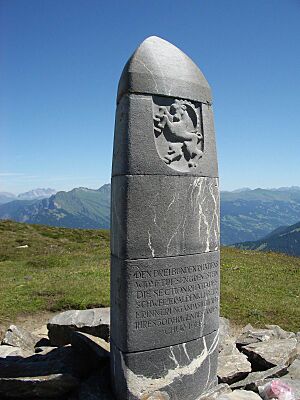Malix facts for kids
Quick facts for kids
Malix
|
||
|---|---|---|
 |
||
|
||
| Country | Switzerland | |
| Canton | Graubünden | |
| District | Plessur | |
| Area | ||
| • Total | 12.60 km2 (4.86 sq mi) | |
| Elevation | 1,116 m (3,661 ft) | |
| Population | ||
| • Total | 709 | |
| • Density | 56.27/km2 (145.74/sq mi) | |
| Postal code |
7074
|
|
| Surrounded by | Churwalden, Chur, Domat/Ems, Scheid | |
Malix was once a small town, also known as a municipality, located in the Plessur area of the canton of Graubünden in Switzerland. On January 1, 2010, Malix joined with another town called Parpan. Together, they became part of the larger municipality of Churwalden.
Contents
History of Malix
Malix is a very old place! It was first mentioned in official records way back in 1149. Back then, it was known by a different name: in Umbilico.
Where is Malix? (Geography)
Malix covers an area of about 12.6 square kilometers (about 4.8 square miles). A big part of this land, almost 42%, is used for farming. Forests cover even more, about 46.7% of the area.
About 4.8% of Malix is covered by buildings and roads where people live and travel. The rest of the land, about 6.6%, includes things like rivers, glaciers, or mountains that aren't used for farming or building.
Malix is located in a valley called Churwalden. It includes the main village of Malix, which is a haufendorf village. This means it grew in an unplanned way, with houses packed closely around a central area. Malix also includes smaller parts called Kreuz and Spina. As you learned, Malix and Parpan officially became part of Churwalden on January 1, 2010.
Who Lives in Malix? (Demographics)
In 2008, Malix had a population of 709 people. About 11.4% of these residents were from other countries. Over the ten years before 2008, the number of people living in Malix grew by about 4.3%.
Languages Spoken in Malix
Most people in Malix speak German. In 2000, about 90.6% of the population spoke German. The second most common language was Romansh, spoken by about 3.6% of residents. Serbo-Croatian was the third most common language, spoken by about 2.6%.
Age Groups in Malix
In 2000, the population of Malix was almost evenly split between males and females. About 49.6% were male and 50.4% were female.
Here's a look at the different age groups:
- Children (0-9 years old): 91 children, or 13.7% of the population.
- Young Teens (10-14 years old): 51 teenagers, or 7.7%.
- Older Teens (15-19 years old): 35 teenagers, or 5.3%.
- Young Adults (20-29 years old): 64 people, or 9.7%.
- Adults (30-39 years old): 114 people, or 17.2%.
- Middle-aged Adults (40-49 years old): 103 people, or 15.5%.
- Older Adults (50-59 years old): 77 people, or 11.6%.
- Seniors (60-69 years old): 70 people, or 10.6%.
- Elderly (70-79 years old): 33 people, or 5.0%.
- Very Elderly (80-89 years old): 22 people, or 3.3%.
- Oldest Residents (90-99 years old): 3 people, or 0.5%.
Education and Jobs in Malix
People in Switzerland are generally well-educated. In Malix, about 80.8% of adults (aged 25–64) have completed either high school or gone on to higher education, like a university.
The unemployment rate in Malix was quite low, at 1.96%. This means most people who wanted a job had one.
In 2005, people in Malix worked in different types of jobs:
- Primary Sector: 26 people worked in jobs related to getting raw materials, like farming. There were about 10 businesses in this area.
- Secondary Sector: 28 people worked in jobs that involve making things, like factories. There were 6 businesses in this area.
- Tertiary Sector: 74 people worked in jobs that provide services, like shops, restaurants, or offices. There were 20 businesses in this area.
Historical Population Trends
Here's how the population of Malix has changed over many years:
| year | population |
|---|---|
| 1623 | around 375 |
| 1850 | 426 |
| 1900 | 340 |
| 1950 | 450 |
| 2000 | 663 |
The Dreibündenstein Landmark
The Dreibündenstein is a special stone marker. Its name means "Three Leagues Stone" in German, and in the local Romansh it's called Term bel. This stone was put in place to mark the exact spot where the borders of three important historical groups met. These groups were the League of God's House, the League of the Ten Jurisdictions, and the Grey League. These three leagues eventually came together to form the modern canton of Graubünden.
The Dreibündenstein is located high up in the mountains, at an altitude of about 2,160 meters (about 7,087 feet). It sits on the border where the municipalities of Domat/Ems, Scheid (which is now part of Tomils), and Malix meet.
The very first stone marker was from 1722. You can see that original stone today in the Rätian Museum in Chur. In 1742, a writer named Nicolin Sererhard mentioned that there were actually three stones marking the spot. The stone you see today, which is 2 meters (about 6.5 feet) tall, was built in 1915 by a group called the "Sektion Rhätia" of the Swiss Alpine Club. To make it easier for people to visit this important landmark, a chair lift was added to the mountain in 1970.
See also
 In Spanish: Malix para niños
In Spanish: Malix para niños






